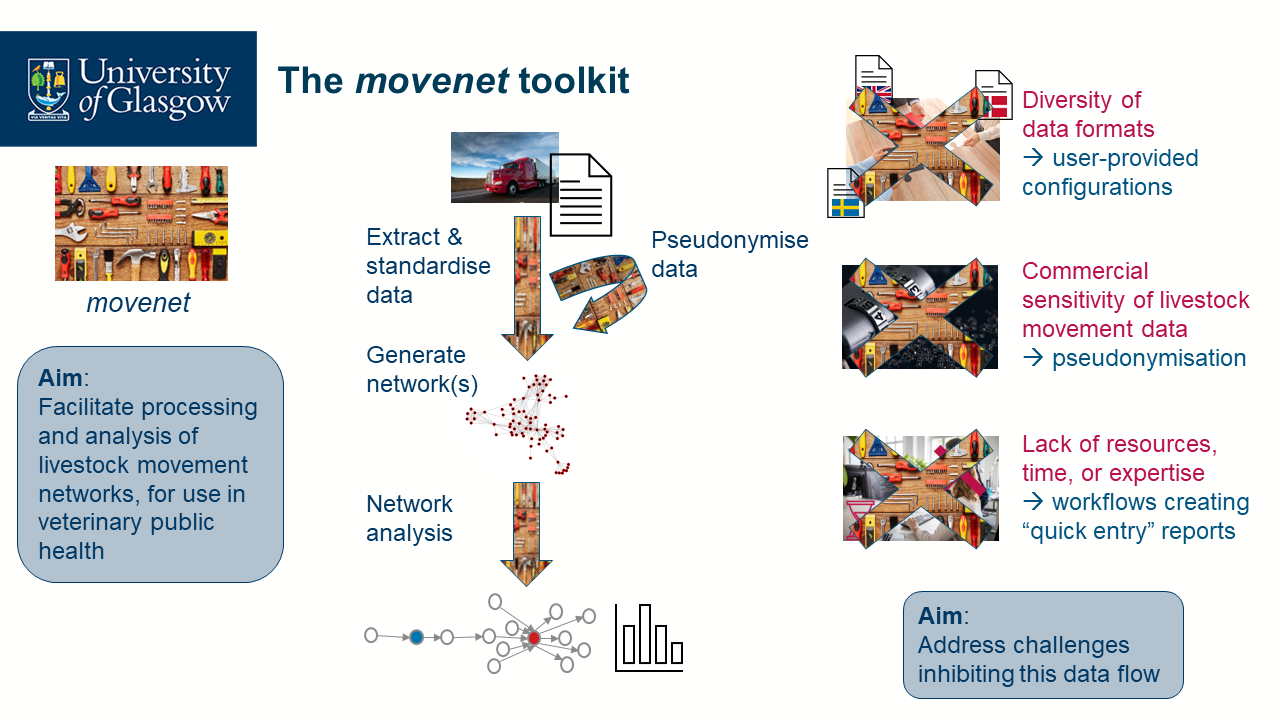The goal of movenet is to simplify the effective use of livestock movement data in veterinary public health. It facilitates the dataflow from livestock movement data to social network analysis, while addressing common data issues such as the diversity of data formats and privacy preservation.

movenet is being developed in the context of the NordForsk Digitalisation of livestock data to improve veterinary public health (DigiVet) project.
Disclaimer: movenet is under active development. The way functions are called, and the internal methods, may still change without prior warning.
Workflows
movenet includes a range of workflows for the processing and analysis of livestock movement data and (optional) holding data:
standardisation of data into a single format, allowing for interoperability and integration of data from different countries or systems
pseudonymisation of livestock movement and/or holding data, to improve the potential for data sharing and collaborative analysis
generation of network representations, and social network analysis, of livestock movement data
exploration of the effects of different pseudonymisation strategies on network properties, so as to allow users to find a suitable balance between the identifiability of the data and the accuracy of these properties.
For more detail on each of these workflows, including sample code, see the vignettes.
Shiny app
In addition to the basic functions in the movenet package, we are developing an accompanying Shiny app to cater to users who prefer a graphical user interface. For further information on the movenet app, see its GitHub repository.
Installation
You can install the development version of movenet from GitHub with:
# install.packages("devtools")
devtools::install_github("digivet-consortium/movenet")Usage
To get started with movenet, first load a config file to tell movenet how to read your data, and then read in a data file:
library(movenet)
# Load an example movement config file:
load_config(system.file("configurations", "ScotEID.yml", package = "movenet"))
#> Successfully loaded config file: C:/Users/cboga/OneDrive - University of Glasgow/Documents/R/win-library/4.1/movenet/configurations/ScotEID.yml
# Read in and reformat an example movement data file:
movement_data <-
reformat_data(system.file("extdata", "example_movement_data.csv", package = "movenet"),
type = "movement")
# Load an example holding config file:
load_config(system.file("configurations", "fakeScotEID_holding.yml", package = "movenet"))
#> Successfully loaded config file: C:/Users/cboga/OneDrive - University of Glasgow/Documents/R/win-library/4.1/movenet/configurations/fakeScotEID_holding.yml
# Read in and reformat an example holding data file:
holding_data <-
reformat_data(system.file("extdata", "example_holding_data.csv", package = "movenet"),
type = "holding")The movement and holding data are now in the right format (movenet-format data tibbles) to be plugged into pseudonymisation, network analysis, and transmission modelling workflows. See vignette("movenet") for more details on these data reading/reformatting steps, and the other vignettes for more information on the various workflows.